Lilongwe, the capital of Malawi, is home to various birds. The city is near Lake Malawi, home to many different species of waterfowl, and its lush vegetation provides a habitat for many other species of birds.
The city also contains several parks and nature reserves, which are excellent locations for bird watching and bird photography. The diversity of bird species in Lilongwe is impressive, ranging from egrets and herons to eagles, hawks, and vultures.
Seeing birds in their natural environment is a great way to experience the city’s beauty.
24 Birds to Watch in Lilongwe
Lilongwe, the capital of Malawi, is a birdwatcher’s paradise. The city is located near Lake Malawi, one of the world’s largest and most biodiverse lakes. It has a variety of habitats that support a rich diversity of birdlife.
Whether a beginner or an expert, you will find plenty of birds to watch and enjoy in Lilongwe. Here are 24 of them that you should not miss.
1. Helmeted Guineafowl
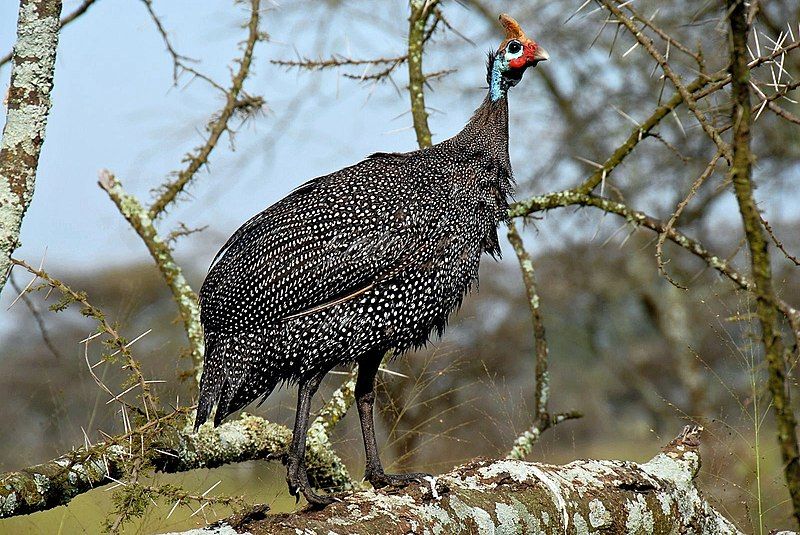
The helmeted guineafowl is a unique bird species belonging to the family Numididae. It is the only member of the genus Numida and is native to Africa, mainly south of the Sahara desert.
This guineafowl has been widely introduced to other parts of the world, such as the West Indies, North America, Colombia, Brazil, Australia, and Europe. It has been domesticated in these regions and is now kept in many countries as a pet and game bird.
The helmeted guineafowl is a hardy bird easily recognizable by its distinctive black and white plumage and helmet-like crest. It feeds mainly on insects, fruits, and seeds and can often be seen scratching in the ground foraging for food.
In addition, it has an array of loud vocalizations and is known to make various loud calls and clucking noises.
The helmeted guineafowl is an essential species in its native habitat, where it is hunted for its meat and feathers, which are used to make traditional headdresses.
| Kingdom | Animalia |
| Phylum | Chordata |
| Class | Aves |
| Order | Galliformes |
| Family | Numididae |
| Genus | Numida |
| Species | N. meleagris |
2. Laughing Dove
The laughing dove is a small pigeon species native to Africa, the Middle East, South Asia, and Western Australia. It is a resident breeder, meaning it breeds in the same area where it lives.
In Western Australia, the laughing dove has been able to establish itself in the wild after being released from Perth Zoo in 1898. This bird species is notable for its distinctive calls, which sound like a soft chuckle.
It has a grey-brown back, a pale pinkish breast, and a black-and-white neck patch. It feeds mainly on seeds and small insects and usually nests in small trees and shrubs.
The laughing dove is quite common in its range, although its numbers have declined due to habitat destruction and other human activities.
| Kingdom | Animalia |
| Phylum | Chordata |
| Class | Aves |
| Order | Columbiformes |
| Family | Columbidae |
| Genus | Spilopelia |
| Species | S. senegalensis |
3. Great Cormorant
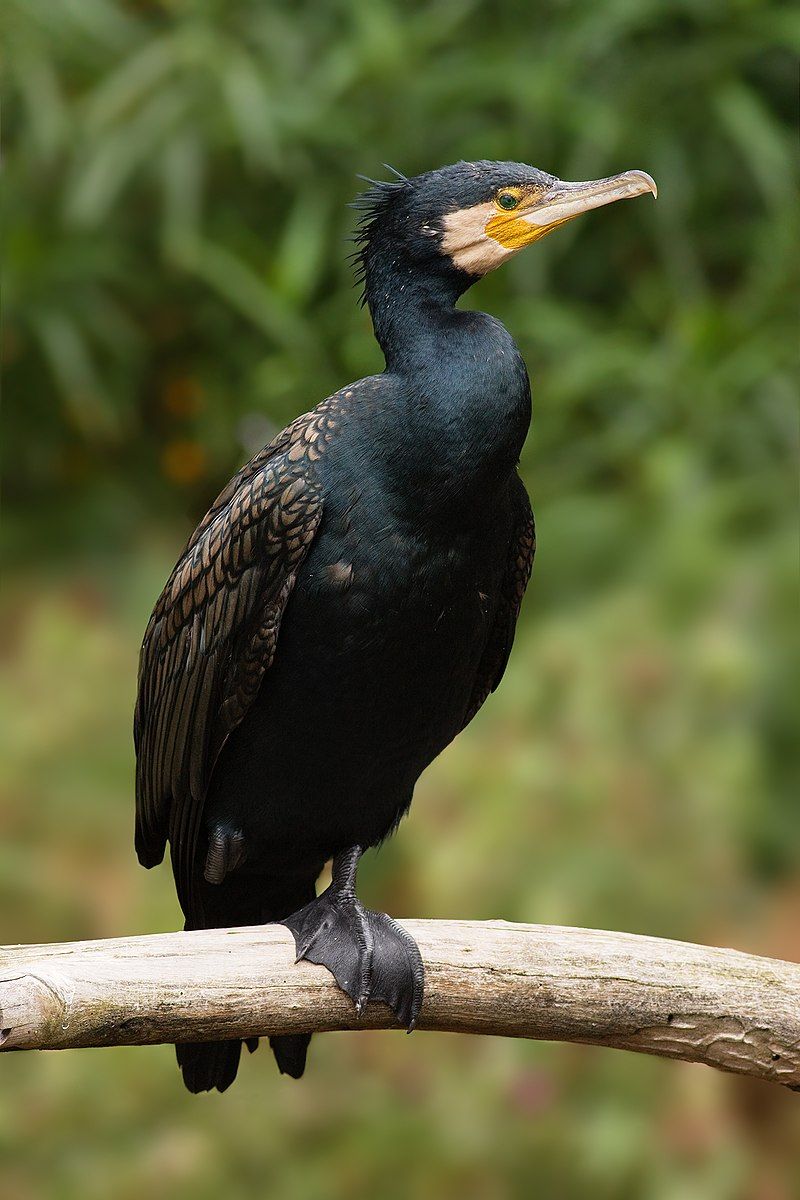
The great cormorant is a seabird species common across the Northern Hemisphere and other regions worldwide.
It is known by different names in different places, such as the black shag or kawau in New Zealand, the great black cormorant in the Northern Hemisphere, the black cormorant in Australia, and the large cormorant in India.
It is a member of the cormorant family and can be found in various habitats, from coastal regions to inland lakes. The great cormorant is easily recognizable due to its black body, yellowish-green bill, and feet.
It has a wingspan of up to 1.2 meters and can reach a length of up to 90 cm. It feeds mainly on fish but can also eat crustaceans, amphibians, and other aquatic animals.
Its diet changes with the availability of prey, and the bird can dive to depths of up to 10 meters to catch its food. The great cormorant is a social species and can often be seen in large flocks, roosting on rocks, or in trees near the water’s edge.
It nests in colonies, often building its nest in the same tree as other cormorants or in cavities in cliffs.
The birds lay two to four eggs per clutch, and the chicks are cared for by both parents. Overall, the great cormorant is a widespread and successful species of seabird that is commonly found across the world.
It is highly adaptable and can be found in various habitats, making it a resilient species that will continue to thrive.
| Kingdom | Animalia |
| Phylum | Chordata |
| Class | Aves |
| Order | Suliformes |
| Family | Phalacrocoracidae |
| Genus | Phalacrocorax |
| Species | P. carbo |
4. African Black Duck
The African black duck (Anas sparsa) belongs to the genus Anas. It is closely related to the mallard group of ducks, but it has distinct differences in behavior and physical features.
These unique characteristics have led scientists to place the African black duck into a subgenus, Melananas, until further research can be done. The African black duck has a dark brown or black plumage, with lighter brown or gray feathers on its head, neck, and breast.
Its bill is yellowish-green, and its legs are dark olive-green. It is similar in size to a mallard, and males and females look alike.
In terms of behavior, the African black duck is usually found in pairs or small groups, whereas the mallard is more likely to be found in larger flocks. The African black duck is also more secretive than the mallard and is rarely seen in open areas.
The African black duck’s call is usually quieter than the mallard’s.In conclusion, the African black duck is a species closely related to the mallard, but it has some unique features that set it apart.
It has darker plumage and is found in smaller groups, and its behavior is more secretive. As a result, it has been placed in its subgenus until further research can be conducted.
| Kingdom | Animalia |
| Phylum | Chordata |
| Class | Aves |
| Order | Anseriformes |
| Family | Anatidae |
| Genus | Anas |
| Species | A. sparsa |
5. Livingstone’s Turaco
Livingstone’s turaco is a species of bird found in southeastern Africa. It belongs to the family Musophagidae, which includes many species of turacos, also known as plantain-eaters. The species is named after Charles Livingstone, the brother of famous explorer David Livingstone.
This bird species is found in the subtropical lowlands of southeastern Africa, mainly in Zambia, Mozambique, and Malawi. Livingstone’s turaco is a medium-sized bird, with males reaching lengths of around 25 cm and females slightly smaller.
They have bright green and yellow feathers, with a red bill and legs. The birds typically live in woodlands, open scrublands, and swamps, where they forage for berries, fruits, and insects. They often build their nests in trees and lay one to two eggs at a time.
Livingstone’s turaco is a threatened species due to habitat destruction and hunting for food. Conservation efforts are underway to protect the species from extinction.
This includes reforestation of its natural habitats and educational campaigns to promote the protection of the species.
| Kingdom | Animalia |
| Phylum | Chordata |
| Class | Aves |
| Order | Musophagiformes |
| Family | Musophagidae |
| Genus | Tauraco |
| Species | T. livingstonii |
6. Turacos
The turacos are a family of birds known as Musophagidae. This family includes plantain eaters and go-away birds. In southern Africa, both of these birds are commonly referred to as “lorries.”
They have a unique type of feet known as semi-zygodactylous, meaning their fourth toe can be switched back and forth. This adaptation gives them a better grip while climbing and hopping between branches.
It also helps them to have a better grip on their prey while they are hunting. Their strong feet and diet of mainly fruits, plants, and insects make them essential to the African ecosystem.
| Kingdom | Animalia |
| Phylum | Chordata |
| Class | Aves |
| Clade | Otidimorphae |
| Order | Musophagiformes |
| Family | Musophagidae |
7. Guineafowl
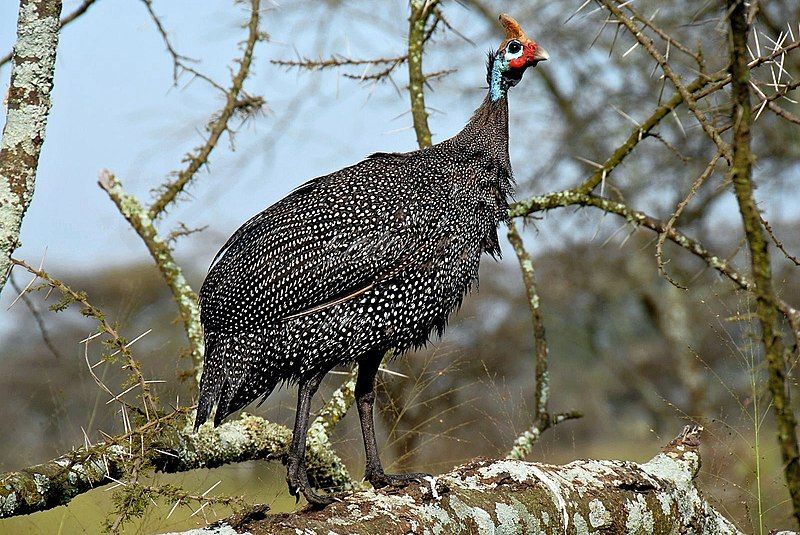
Guineafowl are birds native to Africa and belong to the family Numididae in the order Galliformes. This family of birds is one of the oldest among the gallinaceous birds, meaning they have been around for a long time.
Phylogenetically, they are classified as having branched off from the core Galliformes, the leading group of birds in the order, after the Cracidae and before the Odontophoridae.
This means that guineafowl are closer in evolution to the Cracidae than they are to the Odontophoridae. This is essential information as it provides insight into the evolution of this family of birds and their relationship to other birds in the order.
| Kingdom | Animalia |
| Phylum | Chordata |
| Class | Aves |
| Order | Galliformes |
| Family | Numididae |
8. African Harrier-hawk
The African harrier-hawk is a bird of prey native to Africa. It is a medium-sized bird, measuring about 60-66 cm long. It is found in most parts of Africa south of the Sahara desert.
It is the only member of its genus and is closely related to the allopatric Madagascar harrier-hawk found on the nearby island of Madagascar. The African harrier-hawk is an opportunistic hunter, preying on small animals such as rodents, frogs, and lizards.
When hunting, it often uses the element of surprise, swooping down suddenly from the sky onto its unsuspecting prey.
It is also known to hunt in pairs, with one bird driving its prey towards another. The African harrier-hawk is mainly a solitary species, but during the breeding season, they form pairs and can be seen nesting in tall trees or on cliffs.
They feed their young with small animals that they have caught. The female harrier-hawk often incubates the eggs, and both parents feed the young. The African harrier-hawk is a species of conservation concern due to habitat loss and degradation.
It is listed as “Near Threatened” on the IUCN Red List. Conservation efforts are needed to protect this majestic bird and its unique habitat.
| Kingdom | Animalia |
| Phylum | Chordata |
| Class | Aves |
| Order | Accipitriformes |
| Family | Accipitridae |
| Genus | Polyboroides |
| Species | P. typus |
9. Kingfishers
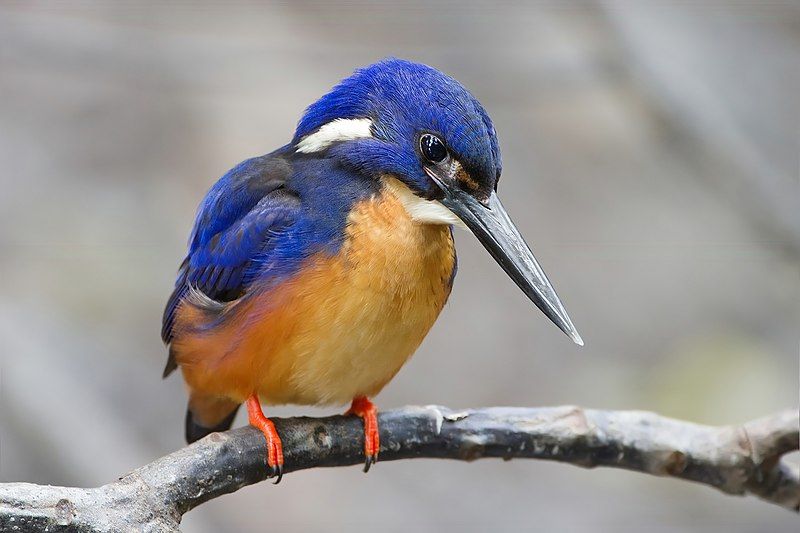
Kingfishers belong to the family Alcedinidae, which is part of the order Coraciiformes. This family of birds is known for being small to medium-sized and brightly colored.
They are found worldwide, with most species located in the tropical regions of Africa, Asia, and Oceania. However, some species can also be seen in Europe.
Kingfishers live near rivers, lakes, and other water bodies, where they can be seen perched near the shoreline, often diving into the water to catch fish. Their unique hunting technique uses sharp, pointed beaks to snatch their prey quickly.
Kingfishers also have a distinctive call: a repetitive “k-k-k” sound.
| Kingdom | Animalia |
| Phylum | Chordata |
| Class | Aves |
| Order | Coraciiformes |
| Family | Alcedinidae |
10. Greater Flamingo
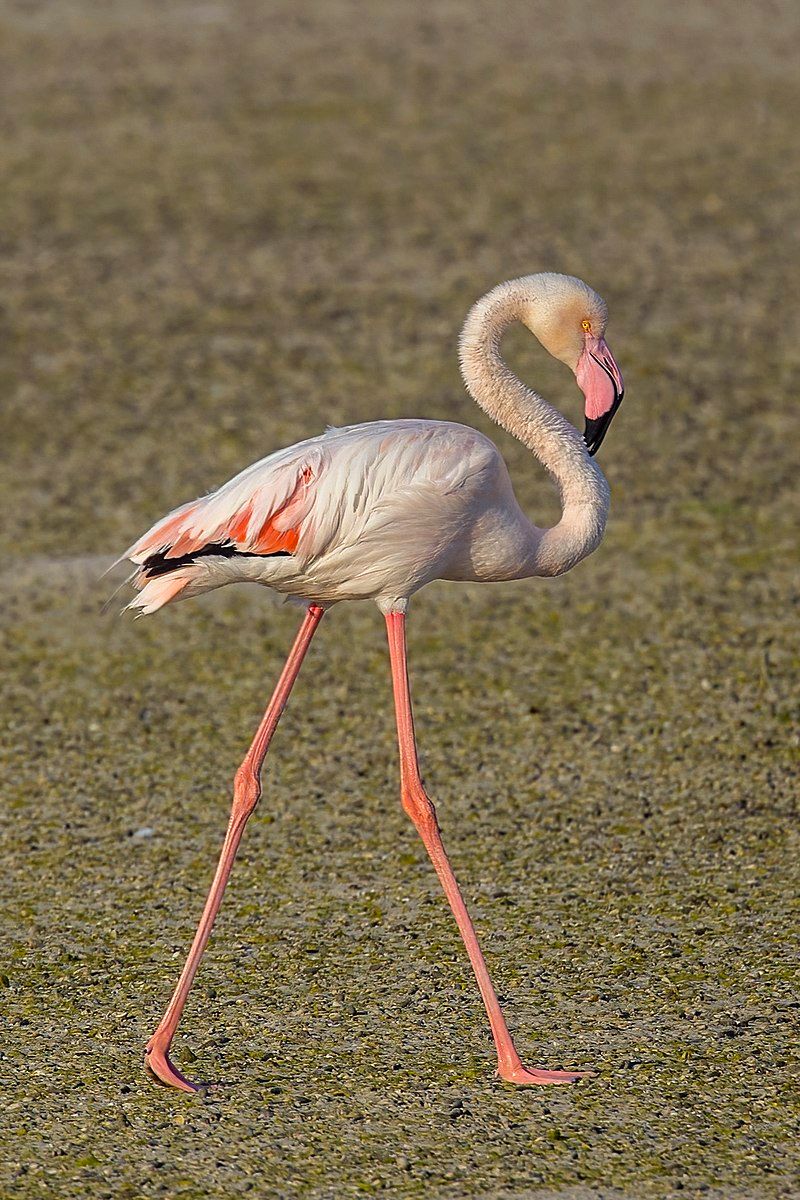
The greater flamingo is a species of flamingo that is the most widespread and most significant.
It is found in many parts of the world, including Northern and Sub-Saharan Africa, the Indian Subcontinent, the Middle East, the Levant, the Persian Gulf, the Gulf of Aden, the Red Sea, and the Mediterranean countries of Southern Europe.
This species of flamingo is a common sight in the Old World, as it inhabits many regions in this region. The greater flamingo is a large, tall bird with a long neck and a curved bill.
It is primarily pink or white, with a bright pink or reddish hue on its face, neck, and wings. Its long legs help it wade in shallow water, and its bill is adapted to sifting through mud to find food.
The greater flamingo is a social bird forming large colonies with hundreds or thousands of individuals. The greater flamingo is an omnivore, which eats animal and plant material.
Its diet consists of small crabs, insects, mollusks, other invertebrates, algae, and plant matter.
This species of flamingo migrates seasonally and can travel up to thousands of miles to find suitable breeding and feeding grounds. The greater flamingo is an iconic species symbolizing many of the regions in which it is found.
It is a popular subject of photography, art, and literature, and its beauty and grace make it one of the most captivating bird species. Unfortunately, its population is declining due to habitat loss, overfishing, and other human activities.
The greater flamingo is an essential species that needs to be protected and preserved for future generations.
| Kingdom | Animalia |
| Phylum | Chordata |
| Class | Aves |
| Order | Phoenicopteriformes |
| Family | Phoenicopteridae |
| Genus | Phoenicopterus |
| Species | P. roseus |
11. Lesser kestrel
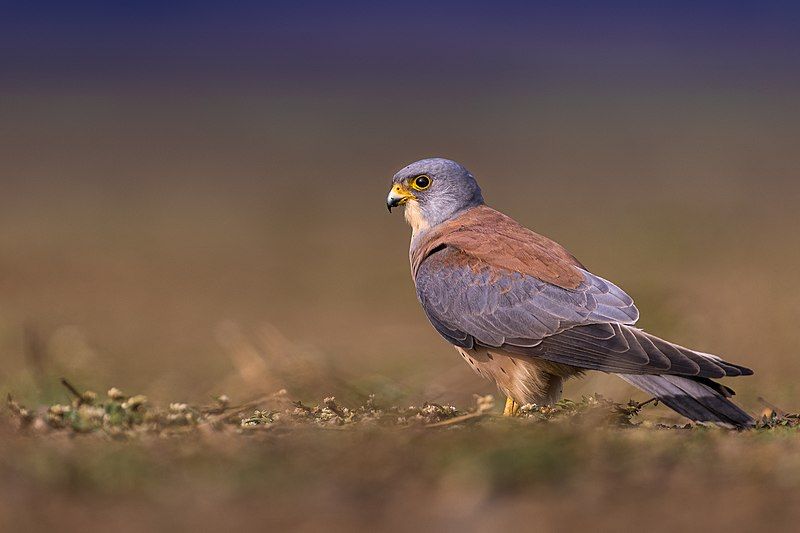
The lesser kestrel is a small falcon species distributed across a wide range of habitats in Eurasia. It is found across the Mediterranean, Afghanistan, Central Asia, China, and Mongolia.
During the summer, the lesser kestrel migrates to warmer climates, such as Africa, Pakistan, India, and Iraq. It is a rare sight in northern regions of its breeding range, and its population has decreased in Europe.
The lesser kestrel is considered a vulnerable species due to a decrease in its population size and the destruction of its habitat in areas where it breeds.
Conservation efforts have been implemented to ensure the survival of this species, such as the creation of protected areas and the implementation of captive breeding and release programs.
| Kingdom | Animalia |
| Phylum | Chordata |
| Class | Aves |
| Order | Falconiformes |
| Family | Falconidae |
| Genus | Falco |
| Species | F. naumanni |
12. Hamerkop
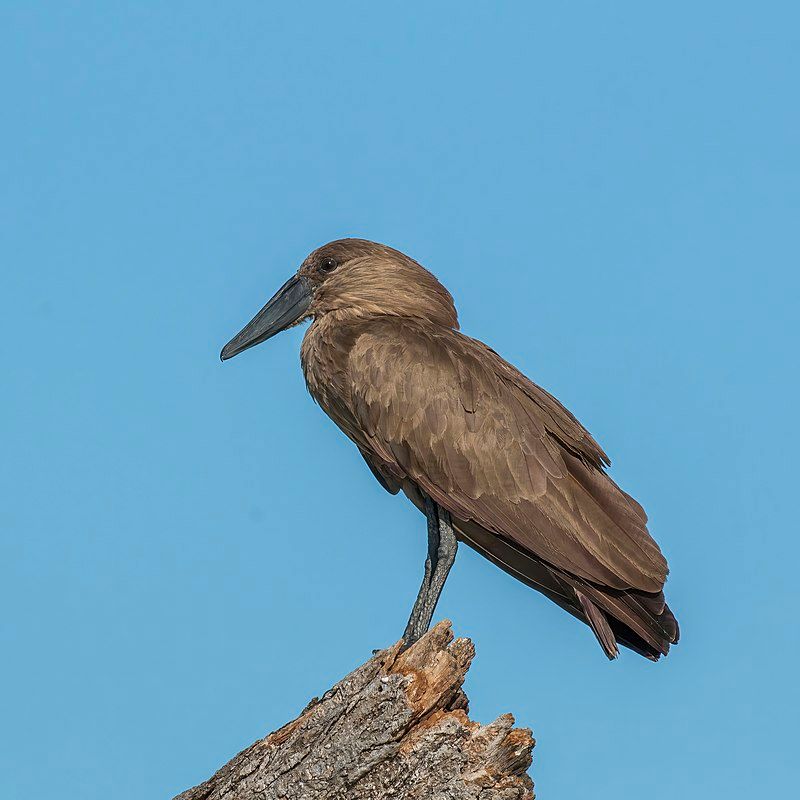
The hamerkop is a medium-sized wading bird that is the only living species in the genus Scopus and the family Scopidae. For a long time, the species and family were considered part of the Ciconiiformes, a group of birds including storks, herons, and ibises.
However, recent studies have suggested that the hamerkop is more closely related to the Pelecaniformes, a group of birds that includes pelicans and shoebills.
This means the hamerkop is now placed in the same family as pelicans and shoebills, making them its closest relatives.
Even though they look very different, the hamerkop shares some important features with these two species, such as a bill structure and a similar feeding style. This further confirms the hamerkop’s place in the Pelecaniformes.
| Kingdom | Animalia |
| Phylum | Chordata |
| Class | Aves |
| Order | Pelecaniformes |
| Family | Scopidae |
| Genus | Scopus |
| Species | S. umbretta |
13. Red-winged Francolin
The red-winged francolin is a species of bird that belongs to the Phasianidae family, also known as the pheasant family.
This bird species can be found in many African countries, such as Angola, Burundi, the Democratic Republic of the Congo, Kenya, Lesotho, Malawi, Rwanda, South Africa, Eswatini, Tanzania, Uganda, and Zambia. Elgon francolin may be a hybrid between the red-winged and moorland francolin.
This hybridization occurs when two different species of birds mate and produce offspring. In this case, the red-winged francolin and the moorland francolin may have made a new species of bird known as the Elogon francolin.
This hybrid species could have adapted to the environment in which it lives and could possess characteristics of both of its parent species. This hybrid species could help increase the diversity of bird populations in Africa and potentially become a new bird species.
| Kingdom | Animalia |
| Phylum | Chordata |
| Class | Aves |
| Order | Galliformes |
| Family | Phasianidae |
| Genus | Scleroptila |
| Species | S. levaillantii |
14. Pallid Harrier
The pale or pallid harrier is a migratory bird of prey belonging to the harrier subfamily. This bird is scientifically named after Ancient Greek words, as ‘Circus’ comes from the Greek word ‘Kirkus,’ which translates to ‘bird of prey.’
This likely references the hen harrier, the most common species.
The second part of the scientific name, macrourus, is derived from two different Greek words, ‘macros’ meaning ‘long’ and ‘ours’ meaning ‘tailed,’ combined to create a word for a ‘long-tailed’ bird.
Therefore, the scientific name of this bird of prey refers to its circling flight, likely referencing the hen harrier and its long tail.
| Kingdom | Animalia |
| Phylum | Chordata |
| Class | Aves |
| Order | Accipitriformes |
| Family | Accipitridae |
| Genus | Circus |
| Species | C. macrourus |
15. Long-crested Eagle
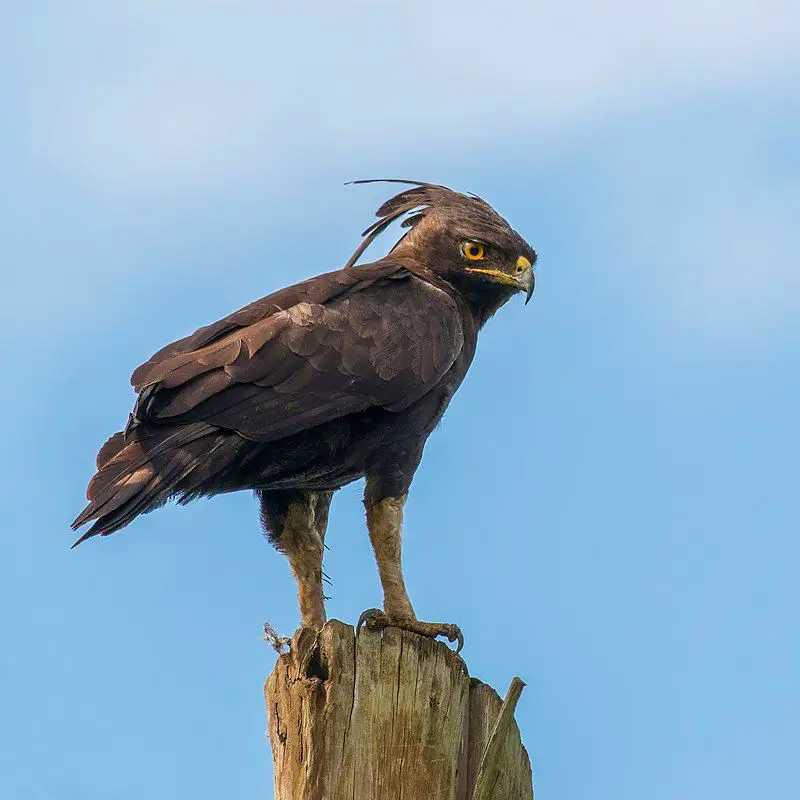
The long-crested eagle is an African prey bird belonging to the Accipitridae family. This type of eagle is placed in its genus, Lophaetus.
The long-crested eagle stands out from other species in the Accipitridae family because of its distinctively shaggy feathers that make up its crest. This long crest covers the entire back of the head and neck and is a characteristic feature of this bird of prey.
The long-crested eagle also has a unique brown and yellow plumage, a white belly, and a broad, black tail. The long-crested eagle is a large bird, usually measuring around 70 cm long and weighing up to 2.7 kg. It has a wingspan of up to 150 cm.
This bird of prey is most active during the day, when it can soar in the air, searching for prey. It mainly feeds on small animals such as rodents, birds, and lizards. The long-crested eagle is a solitary creature rarely seen in large groups.
It is classified as a species of minor concern due to its wide distribution across Africa and its stable population.
| Kingdom | Animalia |
| Phylum | Chordata |
| Class | Aves |
| Order | Accipitriformes |
| Family | Accipitridae |
| Genus | Lophaetus |
| Species | L. occipitalis |
16. Black Goshawk
The black sparrowhawk is a species of True hawk found in Africa. It is also referred to as the black goshawk or great sparrowhawk. This species is the largest in Africa and is easily recognizable by its black body and white head.
It has a mighty wingspan that can stretch up to three feet in length, allowing it to soar through the air with ease.
Its legs and nails are also strong, allowing it to catch prey with a swift and precise strike. The black sparrowhawk is found in various African habitats, including savannahs, grasslands, and forests.
They typically hunt for small mammals, such as rodents and lizards, and feed on birds, reptiles, and insects.
It is an opportunistic hunter who can adapt its hunting strategy based on food availability. This species of True Hawk is a solitary bird, typically residing in areas with little human disturbance.
They are often seen perched atop trees, watching for potential prey, or on a cliff overlooking a body of water.
They are also very territorial and aggressively defend their territory from other birds. The black sparrowhawk is an essential indicator of the health of the African environment. Its presence indicates a healthy balance of prey and predator species.
It is also a symbol of African wildlife and serves as a reminder of the importance of conservation.
| Kingdom | Animalia |
| Phylum | Chordata |
| Class | Aves |
| Order | Accipitriformes |
| Family | Accipitridae |
| Genus | Accipiter |
| Species | A. melanoleucus |
17. Double-banded Sandgrouse
The double-banded sandgrouse is a species of bird that is mostly found living on the ground instead of in the air. It is a member of the family Pteroclidae, known for its terrestrial birds.
This species of bird is native to arid areas of southern Africa, which is an area that is characterized by very little rainfall and a lack of moisture.
This bird has adapted to thrive in these conditions, as it can easily find food and shelter on the ground instead of flying.
The double-banded sandgrouse has a distinctive two-banded pattern on its body, which helps it blend in with its environment and stay safe from predators.
The lack of moisture found in its native habitat does not affect the double-banded sandgrouse, as it can find enough food and water sources to survive.
| Kingdom | Animalia |
| Phylum | Chordata |
| Class | Aves |
| Order | Pterocliformes |
| Family | Pteroclidae |
| Genus | Pterocles |
| Species | P. bicinctus |
18. Buttonquail
Buttonquail, also known as hemipodes, are a unique species of bird belonging to the Turnicidae family. They are found in warm grasslands across Asia, Africa, Europe and Australia.
Although they look similar to quails, a part of the Phasianidae family, they are not closely related. Buttonquails are small birds, usually measuring 13 and 18 cm long.
They are characterized by their short, rounded wings and short legs, which make them well-adapted for running on the ground. They have a strong, curved bill to probe the ground for food.
The feathers are usually patterned with mottled browns and yellows, giving them a hidden appearance. These birds feed mainly on insects, spiders, worms, seeds, and leaves. They can also eat small lizards, frogs, and other small vertebrates.
They are usually found in pairs or small groups, nesting in low vegetation.
They are also known to lay their eggs in the nests of other birds, which helps to protect the eggs from predators. Buttonquails are essential to the ecosystem, as they help control insect populations.
They are popular game birds hunted for sport and food in many parts of their range. Despite this, their populations remain broadly stable and are not considered at risk of extinction.
| Kingdom | Animalia |
| Phylum | Chordata |
| Class | Aves |
| Order | Charadriiformes |
| Family | Turnicidae |
19. Little Grebe
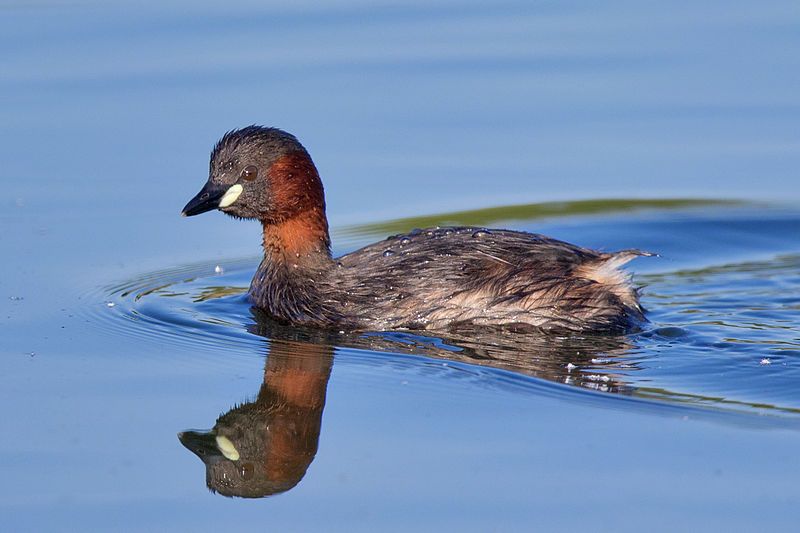
The little grebe, also known as the dabchick, is a species of water bird belonging to the grebe family. Its scientific name, Tachybaptus ruficollis, is derived from Ancient Greek and Latin words.
The genus name, Tachybaptus, is derived from the Ancient Greek words takhus, meaning “fast,” and bapto, meaning “to sink under.” The specific name, ruficollis, is derived from Latin words, rufus meaning “red,” and -collis, meaning “necked.”
“Collis” is derived from the Latin collum, meaning “neck.” This suggests that the little grebe’s neck is red.
| Kingdom | Animalia |
| Phylum | Chordata |
| Class | Aves |
| Order | Podicipediformes |
| Family | Podicipedidae |
| Genus | Tachybaptus |
| Species | T. ruficollis |
20. Barred Long-tailed Cuckoo
The barred long-tailed cuckoo is a species of cuckoo belonging to the Cuculidae family. This cuckoo species is found mainly in the Albertine Rift montane forests of East Africa.
The Albertine Rift montane forests are a chain of mountain forests running along the Albertine Rift, and they are known for their diversity of wildlife. These forests are home to many species of birds, including the barred long-tailed cuckoo.
This cuckoo species can also be found disjunctly throughout East Africa, mainly in areas with suitable habitats. The barred, long-tailed cuckoo is a small bird, usually gray with a bar, red wings and tail, and a long tail.
The diet of this species consists of insects, which they hunt for in the forest canopy.
| Kingdom | Animalia |
| Phylum | Chordata |
| Class | Aves |
| Order | Cuculiformes |
| Family | Cuculidae |
| Genus | Cercococcyx |
| Species | C. montanus |
21. Lilian’s Lovebird
Lilian’s lovebird, also known as the Nyasa lovebird, is a parrot native to Africa. It is a member of the lovebird genus and is one of the smallest parrots in mainland Africa, measuring about 13 cm in length.
This parrot species is mainly green but has some orange on its upper chest and head. Unfortunately, it is not a very common parrot species and is also quite difficult to breed in captivity.
Those successful in breeding this species in captivity are rewarded with a beautiful and rare pet.
| Kingdom | Animalia |
| Phylum | Chordata |
| Class | Aves |
| Order | Psittaciformes |
| Family | Psittaculidae |
| Genus | Agapornis |
| Species | A. lilianae |
22. Southern Yellow-billed Hornbill
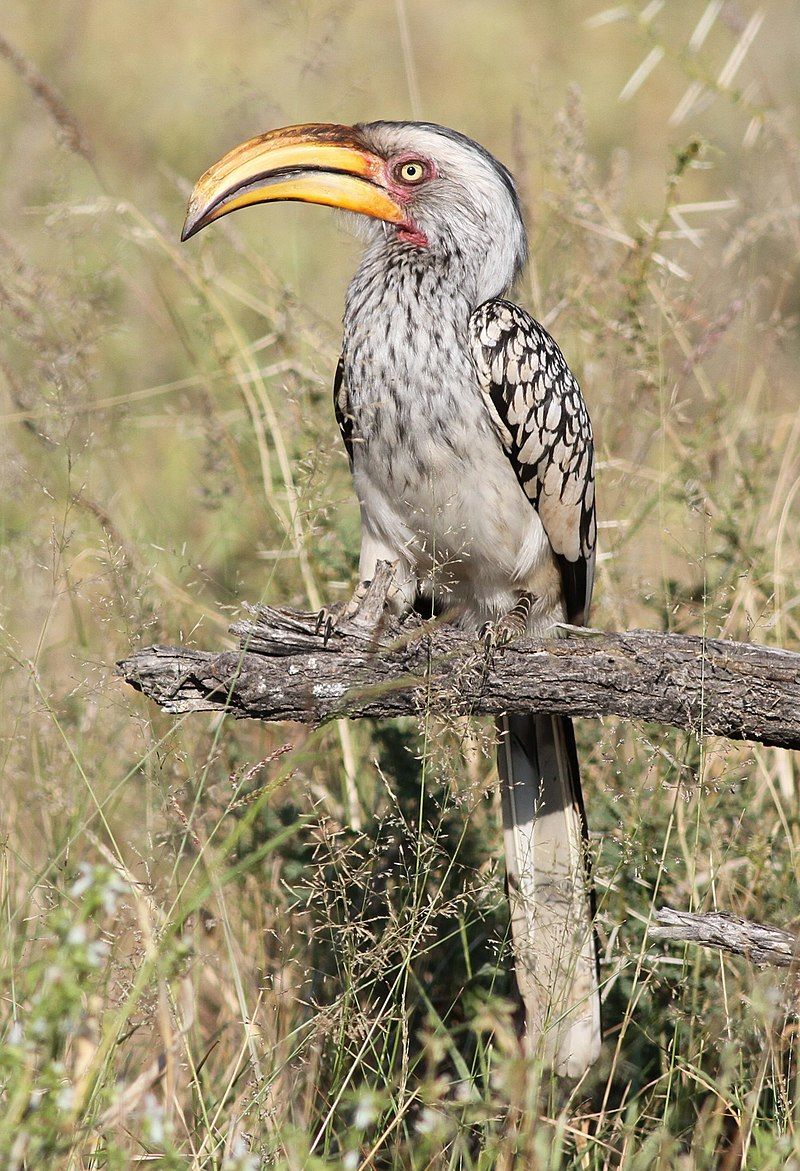
The southern yellow-billed hornbill is a species found in the southern regions of Africa. This hornbill species is characterized by its yellow bill and its diet, which consists mainly of seeds, small insects, spiders, and scorpions.
It is a widespread resident of dry thornveld and broad-leafed woodlands, where it scavenges for food on the ground.
This hornbill species is also highly adaptable and is often found in modified habitats, such as open grassland and near human settlements.
The southern yellow-billed hornbill is an essential species in the African ecosystem, as it plays a significant role in seed dispersal and helps maintain the food chain’s balance. It is also a valuable food source for animals like leopards, jackals, and baboons.
Furthermore, the species is also essential to local human communities, as it helps to control insect populations and thus protect crops. Despite this importance, the southern yellow-billed hornbill is threatened by habitat loss due to human activities.
This includes deforestation, agricultural expansion, and the expansion of urban settlements. As a result, the populations of this species have been declining, and it is now listed as Vulnerable on the IUCN Red List.
The conservation of this species is of utmost importance, and efforts must be taken to restore and protect its natural habitats.
| Kingdom | Animalia |
| Phylum | Chordata |
| Class | Aves |
| Order | Bucerotiformes |
| Family | Bucerotidae |
| Genus | Tockus |
| Species | T. leucomelas |
23. African Green Pigeon
The African green pigeon is a type of bird found across Sub-Saharan Africa. It belongs to the family Columbidae and is one of five green pigeon species that live in the Afrotropics.
The species has a wide range of habitats and is known to have around 17 accepted races. The African green pigeon can be identified by its distinct green plumage and red bill. It is a medium-sized bird that feeds on fruit and seeds and is known to be exceptionally social.
The African green pigeon plays an essential role in the ecosystem, as it helps to disperse the seeds of certain trees and plants. As a result, these species positively affect the environment and contribute to the overall health of the local ecosystem.
| Kingdom | Animalia |
| Phylum | Chordata |
| Class | Aves |
| Order | Columbiformes |
| Family | Columbidae |
| Genus | Treron |
| Species | T. calvus |
24. Scarlet-chested Sunbird
The scarlet-chested sunbird is a species of bird that is part of the family of birds known as Nectariniidae. This family of birds is made up of colorful species found in mostly tropical and sub-tropical regions of the world.
They are most commonly found in Africa but can also be seen in parts of India, Sri Lanka, and Southeast Asia. Scarlet-chested sunbirds are easily identifiable due to their bright red chests and yellow throats.
They are also known for their sharp, pointed bills, which they use to feed on nectar and insects. They have long, slender wings that allow them to maneuver quickly and gracefully through the air.
These birds are social and can be seen in small groups, usually consisting of two to four individuals. They have various calls and songs to communicate with each other.
They are also renowned for their impressive acrobatic displays, which they use to attract mates and protect their territories. The scarlet-chested sunbird is an essential species in the avian world, as it helps to pollinate flowers and disperse seeds.
They are also crucial in controlling insect populations, which helps to maintain a balanced and healthy ecosystem.
| Kingdom | Animalia |
| Phylum | Chordata |
| Class | Aves |
| Order | Passeriformes |
| Family | Nectariniidae |
| Genus | Chalcomitra |
| Species | C. senegalensis |
Conclusion
Birds in Lilongwe are essential to the city’s natural beauty and wildlife. These birds’ presence contributes to the city’s overall atmosphere and vibrancy. They bring joy to the people of Lilongwe and offer a connection to the natural world.
With proper conservation efforts and protection of their habitats, these birds can continue to thrive in the city for years to come.